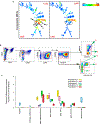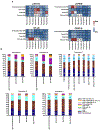Single-cell mass cytometry reveals distinct populations of brain myeloid cells in mouse neuroinflammation and neurodegeneration models
- PMID: 29507414
- PMCID: PMC8629134
- DOI: 10.1038/s41593-018-0100-x
Single-cell mass cytometry reveals distinct populations of brain myeloid cells in mouse neuroinflammation and neurodegeneration models
Abstract
Neuroinflammation and neurodegeneration may represent two poles of brain pathology. Brain myeloid cells, particularly microglia, play key roles in these conditions. We employed single-cell mass cytometry (CyTOF) to compare myeloid cell populations in the experimental autoimmune encephalomyelitis (EAE) model of multiple sclerosis, the R6/2 model of Huntington's disease (HD) and the mutant superoxide dismutase 1 (mSOD1) model of amyotrophic lateral sclerosis (ALS). We identified three myeloid cell populations exclusive to the CNS and present in each disease model. Blood-derived monocytes comprised five populations and migrated to the brain in EAE, but not in HD and ALS models. Single-cell analysis resolved differences in signaling and cytokine production within similar myeloid populations in EAE compared to HD and ALS models. Moreover, these analyses highlighted α5 integrin on myeloid cells as a potential therapeutic target for neuroinflammation. Together, these findings illustrate how neuropathology may differ between inflammatory and degenerative brain disease.
Conflict of interest statement
Competing interests:
The authors declare no competing financial interest.
Figures






Similar articles
-
Excess circulating alternatively activated myeloid (M2) cells accelerate ALS progression while inhibiting experimental autoimmune encephalomyelitis.PLoS One. 2011;6(11):e26921. doi: 10.1371/journal.pone.0026921. Epub 2011 Nov 3. PLoS One. 2011. PMID: 22073221 Free PMC article.
-
Endogenous regulatory T lymphocytes ameliorate amyotrophic lateral sclerosis in mice and correlate with disease progression in patients with amyotrophic lateral sclerosis.Brain. 2011 May;134(Pt 5):1293-314. doi: 10.1093/brain/awr074. Brain. 2011. PMID: 21596768 Free PMC article.
-
TGFβ regulates persistent neuroinflammation by controlling Th1 polarization and ROS production via monocyte-derived dendritic cells.Glia. 2016 Nov;64(11):1925-37. doi: 10.1002/glia.23033. Epub 2016 Aug 1. Glia. 2016. PMID: 27479807 Free PMC article.
-
Microglia and C9orf72 in neuroinflammation and ALS and frontotemporal dementia.J Clin Invest. 2017 Sep 1;127(9):3250-3258. doi: 10.1172/JCI90607. Epub 2017 Jul 24. J Clin Invest. 2017. PMID: 28737506 Free PMC article. Review.
-
Murine Models of Huntington's Disease for Evaluating Therapeutics.Methods Mol Biol. 2018;1780:179-207. doi: 10.1007/978-1-4939-7825-0_10. Methods Mol Biol. 2018. PMID: 29856020 Review.
Cited by
-
Microglial senescence in neurodegeneration: Insights, implications, and therapeutic opportunities.Neuroprotection. 2024 Sep;2(3):182-195. doi: 10.1002/nep3.56. Epub 2024 Sep 15. Neuroprotection. 2024. PMID: 39364217 Free PMC article.
-
Noninvasive Low-Frequency Pulsed Focused Ultrasound Therapy for Rheumatoid Arthritis in Mice.Research (Wash D C). 2022 Dec 19;2022:0013. doi: 10.34133/research.0013. eCollection 2022. Research (Wash D C). 2022. PMID: 39290964 Free PMC article.
-
Evolution of Microglia.Adv Neurobiol. 2024;37:39-51. doi: 10.1007/978-3-031-55529-9_3. Adv Neurobiol. 2024. PMID: 39207685
-
The involvement of effector memory CD4+ T cells in mediating the impact of genus Oscillibacter gut microbiota on Alzheimer's disease: a Mendelian randomization study.Front Aging Neurosci. 2024 Aug 7;16:1423707. doi: 10.3389/fnagi.2024.1423707. eCollection 2024. Front Aging Neurosci. 2024. PMID: 39170894 Free PMC article.
-
Characterizing microglial signaling dynamics during inflammation using single-cell mass cytometry.bioRxiv [Preprint]. 2024 Jul 29:2024.07.27.605444. doi: 10.1101/2024.07.27.605444. bioRxiv. 2024. PMID: 39131388 Free PMC article. Preprint.
References
-
- McGeer PL, Itagaki S, Boyes BE & McGeer EG Reactive microglia are positive for HLA-DR in the substantia nigra of Parkinson’s and Alzheimer’s disease brains. Neurology 38, 1285–1291 (1988). - PubMed
Methods-only references
-
- Linthicum DS, Munoz JJ & Blaskett A Acute experimental autoimmune encephalomyelitis in mice. I. Adjuvant action of Bordetella pertussis is due to vasoactive amine sensitization and increased vascular permeability of the central nervous system. Cell Immunol 73, 299–310 (1982). - PubMed
-
- Hofstetter HH, Shive CL & Forsthuber TG Pertussis toxin modulates the immune response to neuroantigens injected in incomplete Freund’s adjuvant: induction of Th1 cells and experimental autoimmune encephalomyelitis in the presence of high frequencies of Th2 cells. J Immunol 169, 117–125 (2002). - PubMed
-
- Hou W et al. Pertussis toxin enhances Th1 responses by stimulation of dendritic cells. J Immunol 170, 1728–1736 (2003). - PubMed
Publication types
MeSH terms
Substances
Grants and funding
LinkOut - more resources
Full Text Sources
Other Literature Sources
Medical
Molecular Biology Databases
Miscellaneous

